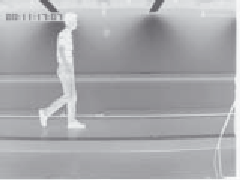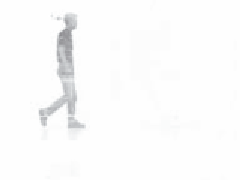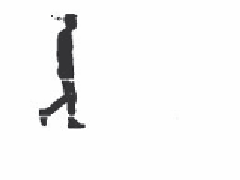Image Processing Reference
In-Depth Information
only find application where the illumination can be carefully controlled. This requirement
is germane to any application that uses basic thresholding. If the overall illumination level
cannot be controlled, then it is possible to threshold edge magnitude data since this is
insensitive to overall brightness level, by virtue of the implicit differencing process. However,
edge data is rarely continuous and there can be gaps in the detected perimeter of a shape.
Another major difficulty, which applies to thresholding the brightness data as well, is that
there are often more shapes than one. If the shapes are on top of each other, one occludes
the other and the shapes need to be separated.
An alternative approach is to
subtract
an image from a known background before
thresholding (we saw how we can estimate the background in Section 3.5.2). This assumes
that the background is known precisely, otherwise many more details than just the target
feature will appear in the resulting image; clearly the subtraction will be unfeasible if there
is
noise
on either image, and especially on both. In this approach, there is no implicit shape
description, but if the thresholding process is sufficient, then it is simple to estimate basic
shape parameters, such as position.
The subtraction approach is illustrated in Figure
5.1
. Here, we seek to separate or extract
the walking subject from the background. We saw earlier, in Figure
3.22
, how the median
filter can be used to provide an estimate of the background to the sequence of images that
Figure
5.1
(a) comes from. When we subtract the background of Figure
3.22
(i) from the
image of Figure
5.1
(a), we obtain most of the subject with some extra background just
behind the subject's head. This is due to the effect of the moving subject on
lighting
.
Also,
removing the background removes some of the subject: the horizontal bars in the background
have been removed from the subject by the subtraction process. These aspects are highlighted
in the thresholded image, Figure
5.1
(c). It is not a particularly poor way of separating the
subject from the background (we have the subject but we have chopped out his midriff) but
it is not especially good either.
(a) Image of walking subject
(b) After background subtraction
(c) After thresholding
Figure 5.1
Shape extraction by subtraction and thresholding
Even though thresholding and subtraction are attractive (because of simplicity and
hence their speed), the performance of both techniques is sensitive to partial shape data, to
noise, variation in illumination and to occlusion of the target shape by other objects.
Accordingly, many approaches to image interpretation use higher level information in
shape extraction, namely how the pixels are connected within the shape. This can resolve
these factors.




















